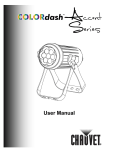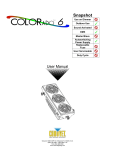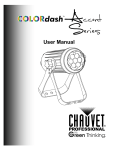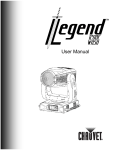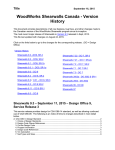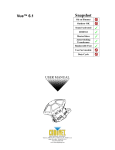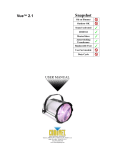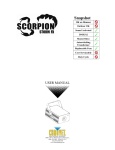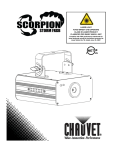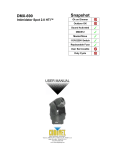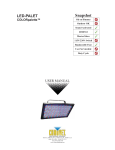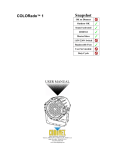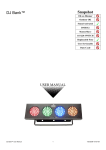Download Chauvet Colordash User manual
Transcript
Snapshot Use on Dimmer Outdoor Use Sound Activated DMX Master/Slave Autoswitching Power Supply Replaceable Fuse User Serviceable Duty Cycle User Manual Chauvet, 3000 N 29th Ct, Hollywood, FL 33020 U.S.A. (800) 762-1084 – (954) 929-1115 FAX (954) 929-5560 www.chauvetlighting.com TABLE OF CONTENTS 1. Before You Begin ...................................................................................................................................... 1 WHAT IS INCLUDED ..................................................................................................................................................................................... 1 UNPACKING INSTRUCTIONS ......................................................................................................................................................................... 1 MANUAL CONVENTIONS .............................................................................................................................................................................. 1 ICONS ....................................................................................................................................................................................................... 1 SAFETY INSTRUCTIONS ............................................................................................................................................................................... 2 LED EXPECTED LIFESPAN .......................................................................................................................................................................... 2 2. Introduction ............................................................................................................................................... 3 FEATURES ................................................................................................................................................................................................. 3 Additional Features ................................................................................................................................................... 3 DMX CHANNEL SUMMARY .......................................................................................................................................................................... 3 PRODUCT DIMENSIONS ............................................................................................................................................................................... 4 3. SETUP ........................................................................................................................................................ 5 AC POWER................................................................................................................................................................................................ 5 MOUNTING................................................................................................................................................................................................. 5 Orientation ................................................................................................................................................................ 5 Rigging ..................................................................................................................................................................... 5 FIXTURE LINKING........................................................................................................................................................................................ 6 DATA CABLING ........................................................................................................................................................................................... 6 DMX Data Cable ....................................................................................................................................................... 7 Cable Connectors ..................................................................................................................................................... 7 3-Pin to 5-Pin Conversion Chart................................................................................................................................ 7 Setting up a DMX Serial Data Link ............................................................................................................................ 8 MASTER/SLAVE FIXTURE LINKING ................................................................................................................................................................ 8 4. Operating Instructions ............................................................................................................................. 9 CONTROL OPTIONS .................................................................................................................................................................................... 9 DIP Switch Summary ................................................................................................................................................ 9 AUTO Mode ............................................................................................................................................................ 10 Static Mode............................................................................................................................................................. 10 Master/Slave Mode ................................................................................................................................................. 11 DMX Mode.............................................................................................................................................................. 11 USING DMX MODE .................................................................................................................................................................................. 11 Setting the Starting DMX address ........................................................................................................................... 12 DMX Addressing Example ...................................................................................................................................... 12 Selecting the Unit’s Personality ............................................................................................................................... 12 Configuring the Starting Address ............................................................................................................................ 13 DMX CHANNEL VALUES ........................................................................................................................................................................... 14 STAGE 1 ................................................................................................................................................................ 14 ARC 1 ..................................................................................................................................................................... 14 ARC 2 ..................................................................................................................................................................... 14 DMX OPERATION NOTES.......................................................................................................................................................................... 15 Color Combination for All Modes............................................................................................................................. 15 STAGE 1 Related Features .................................................................................................................................... 15 CONTACT US ........................................................................................................................................................................................... 15 5. Appendix.................................................................................................................................................. 16 DMX PRIMER .......................................................................................................................................................................................... 16 GENERAL MAINTENANCE ........................................................................................................................................................................... 16 RETURNS PROCEDURE ............................................................................................................................................................................. 17 CLAIMS ................................................................................................................................................................................................... 17 PHOTOMETRIC DATA ................................................................................................................................................................................ 18 COLORDASH™ ACCENT SERVICE MAINTENANCE GUIDE ............................................................................................................................ 19 EXPLODED VIEW ...................................................................................................................................................................................... 20 WIRING DIAGRAM ..................................................................................................................................................................................... 21 TECHNICAL SPECIFICATIONS...................................................................................................................................................................... 22 COLORdash™ Accent User Manual i 6/22/2009 4:15 PM 1. BEFORE YOU BEGIN What is included 1 x COLORdash™ Accent 1 x Warranty Card 1 x User Manual Unpacking Instructions Immediately upon receiving a fixture, carefully unpack the carton, check the contents to ensure that all parts are present, and have been received in good condition. Notify the shipper immediately and retain packing material for inspection if any parts appear damaged from shipping or if the carton shows signs of mishandling. Save the carton and all packing materials. In the event that a fixture must be returned to the factory, it is important that the fixture be returned in the original factory box and packing. Manual Conventions CHAUVET manuals use the following conventions to differentiate certain types of information from the regular text. MEANING CONVENTION [10] A DIP switch to be configured <Menu> A key to be pressed on the fixture’s control panel 1~512 A range of values 50/60 A set of values of which only one can be chosen Settings MENU > Settings A menu option not to be modified (for example, showing the operating mode/current status) A sequence of menu options to be followed A value to be entered or selected ON Icons CHAUVET manuals use the following icons to indicate information that requires special attention on the part of the user. ICONS MEANING This paragraph contains critical installation, configuration or operation information. Failure to comply with this information may render the fixture partially or completely inoperative, cause damage to the fixture or cause harm to the user or technician. This paragraph contains important installation or configuration information. Failure to comply with this information may prevent the fixture from functioning correctly. This paragraph contains useful, although not critical, information. COLORdash™ Accent User Manual 1 6/22/2009 4:15 PM Safety Instructions Please read these instructions carefully because they include important information about the installation, usage and maintenance of this product. There are no user serviceable parts inside the unit. Any reference to servicing the unit you may find from now on will only apply to properly certified technicians. Do not open the housing or attempt any repairs unless you are one of them. In the unlikely event that your unit may require service, please contact CHAUVET at (954) 929-1115. • • • • • • • • • • • • Keep this manual for future consultation. If you sell the unit to another user, make sure that they also receive this manual. Always make sure that you are connecting the unit to the proper voltage, as per the specifications. Always disconnect the unit from the power source before servicing. This product is for indoor use only! To prevent risk of fire or shock, do not expose fixture to rain or moisture. Make sure there are no flammable materials close to the unit while operating. Always secure the fixture to a fastening device using a safety chain. Maximum ambient temperature (Ta) is 104° F (40° C). Do not operate the fixture at a higher temperature. In the event of a serious operating problem, stop using the unit immediately! Never connect the device to a dimmer pack. Make sure the power cord is not crimped or damaged. Never disconnect the power cord by pulling or tugging on the cord. Avoid direct eye exposure to the light source while it is on. Please refer to all applicable local codes and regulations for proper installation of this fixture. LED Expected Lifespan LEDs gradually decline in brightness over time. HEAT is the dominant factor that leads to the acceleration of this decline. Packaged in clusters, LEDs exhibit higher operating temperatures than in ideal or singular optimum conditions. For this reason when all color LEDs are used at their fullest intensity, life of the LEDs is significantly reduced. It is estimated that a viable lifespan of 40,000 to 50,000 hours will be achieved under normal operational conditions. If improving on this lifespan expectancy is of a higher priority, place care in providing for lower operational temperatures. This may include climatic-environmental and the reduction of overall projection intensity COLORdash™ Accent User Manual 2 6/22/2009 4:15 PM 2. INTRODUCTION Features • • • • • • • • • • RGB+W dimmer 0-100% Color macro Strobe Direct DMX input Compatible with COLOR-CON Controller RGB color mixing with or without DMX controller Lightweight aluminum casing Natural convection cooling (no fans) Operating DMX modes 3-channel: RGB control (ARC 1 personality) 4-channel RGB+W control (ARC 2 personality) 9-channel: RGB+W, dim, macro, strobe, automatic (STAGE 1 personality) Operating stand alone modes (no DMX controller) AUTO mode (32 preset programs) Master / Slave (AUTO or STATIC mode on) RGB+W mixing (STATIC mode) Additional Features • • High-power, 1 W (350 mA) LEDs Double-bracket yoke that doubles as floor stand DMX Channel Summary The COLORdash™ Accent has three DMX channel configurations, referred to as “Personalities” in this manual. The three personalities are STAGE 1, ARC 1 and ARC 2. Each of these personalities can be selected with the DIP switches on the back of the unit. Please see the “Operating Instructions” section for a description on how to accomplish this. STAGE 1 CHANNEL DESCRIPTION ARC 1 CHANNEL DESCRIPTION 1 Dimmer 1 Red 2 Red 2 Green 3 Green 3 Blue 4 Blue 5 White 6 Color Macro 1 7 Strobe 2 Green 8 Auto Program Selection 3 Blue 9 Auto Speed Adjustment 4 White COLORdash™ Accent User Manual ARC 2 3 CHANNEL DESCRIPTION Red 6/22/2009 4:15 PM Product Dimensions Width Height Front View Rear View Bracket Adjustment Knob Length Side View COLORdash™ Accent User Manual 4 6/22/2009 4:15 PM 3. SETUP AC Power This fixture has an auto-switching power supply that can accommodate a wide range of input voltages (100 ~ 240 VAC, 50/60 Hz). Before powering on the unit, make sure the line voltage to which you are connecting it is within the range of accepted voltages. Always connect the fixture to a switched circuit. Never connect the fixture to a rheostat (variable resistor) or dimmer circuit, even if the rheostat or dimmer channel is used only as a 0 to 100% switch. To determine the power requirements for a particular fixture, see the label affixed to the back plate of the fixture or refer to the fixture’s specifications chart. A fixture’s listed current rating indicates its average current draw under normal conditions. Always connect the fixture to a circuit with a suitable electrical ground. Mounting Orientation This fixture may be mounted in any safe position, provided there is adequate room for ventilation. Rigging The fixture includes a mounting yoke to which a rigging clamp can be attached. You must supply your own clamp and make sure the clamp is capable of supporting the weight of this fixture. You can order “C” and “O”-clamps from any CHAUVET dealer or distributor (CLP-15, CLP-06 recommended). There are two types of applications for this fixture: floor stand for up lighting, and overhead use for down lighting. If you are using this fixture for down lighting, you must use at least one safety cable/chain for each fixture in addition to the double-bracket yoke. If hanging the fixture for overhead use please follow the below steps: 1) Block access below the work area and use a suitable and stable platform when installing or servicing fixture. 2) Always use safety cables. The safety cable must be capable of holding 10 times the weight of the fixture. 3) Verify that the structure can hold 10 times the weight of all to-be installed fixtures. After prolonged periods of operation, the fixture’s chassis may reach high temperatures. This fixture must be mounted in a ventilated location, as it uses natural convection cooling. COLORdash™ Accent User Manual 5 6/22/2009 4:15 PM Rigging (Cont.) Doublebracket Yoke/Floor Stand Hanging Clamp Bracket Adjustment Knob Mounting clamps are sold separately Fixture Linking You will need a serial data link to run light shows of one or more fixtures using a DMX controller or to run synchronized shows on two or more fixtures set to a master/slave operating mode. The combined number of channels required by all the fixtures on a serial data link determines the number of fixtures the data link can support. The fixtures must be linked using DMX cable in a daisy chain (serial) fashion. To comply with the EIA-485 standard, no more than 32 fixtures should be connected on one daisy chain without using a DMX optically-isolated splitter. Doing otherwise may result in deterioration of the digital DMX signal. USITT recommends limiting the total length of the DMX cable (from the first fixture/controller to the last fixture) to 300 ~ 455 m (985 ~ 1,500 ft). Data Cabling To link fixtures together you must obtain data cables. You can purchase CHAUVET certified DMX cables directly from a dealer/distributor or construct your own cable. If you choose to create your own cable, please use data-grade cables that can carry a high quality signal and are less prone to electromagnetic interference. COLORdash™ Accent User Manual 6 6/22/2009 4:15 PM DMX Data Cable Use a Belden™ 9841 or equivalent cable, which meets the specifications for EIA RS-485 applications. Standard microphone cables cannot transmit DMX data reliably over long distances. The cable must have the following characteristics: Type: shielded, 2-conductor twisted pair Maximum capacitance between conductors: 30 pF/ft Maximum capacitance between conductor and shield: 55 pF/ft Maximum resistance: 20 ohms/1000 ft Nominal impedance: 100 ~ 140 ohms Cable Connectors The cable must have a male XLR connector on one end and a female XLR connector on the other end. DMX connector configuration INPUT OUTPUT COMMON 1 3 2 1 3 2 DMX + DMX - 120 ohm, ¼ W resistor between pin 2 (DMX -) and pin 3 (DMX +) on the output of the last fixture. 1 3 2 To avoid signal transmission problems and interference, it is always advisable to connect a DMX signal terminator, as seen above. Do not allow contact between the common and the fixture’s chassis ground. Grounding the common can cause a ground loop, and your fixture may perform erratically. Test the cables with an ohmmeter to verify correct polarity, and to make sure the pins are not grounded or shorted to each other. 3-Pin to 5-Pin Conversion Chart If you use a controller with a 5-pin DMX output connector, you will need to use a 5-pin to 3-pin adapter. You may use the CHAUVET Model number DMX5M, or DMX5F. The chart below details a proper cable conversion: 3-PIN TO 5-PIN CONVERSION CHART Conductor 3-Pin Female (Output) 5-Pin Male (Input) Ground/Shield Pin 1 Pin 1 Data ( - ) signal Pin 2 Pin 2 Data ( + ) signal Pin 3 Pin 3 Not used Pin 4 Not used Pin 5 COLORdash™ Accent User Manual 7 6/22/2009 4:15 PM Setting up a DMX Serial Data Link 1. Connect the (male) 3-pin connector side of the DMX cable to the output (female) 3-pin connector of the controller. Universal DMX Controller 2. Connect the end of the cable coming from the controller, which will have a (female) 3pin connector to the input connector of the next fixture consisting of a (male) 3-pin connector. 3. Then, proceed to connect from the output as stated above to the input of the following fixture and so on. This drawing provides a general illustration of the DMX input/output panel of a lighting fixture. CHAUVET Certified DMX Data Cables Order Code Description DMX1.5 DMX Cable 1.5 m/4.9 ft DMX4.5 DMX Cable 4.5 m/14.8 ft DMX10 DMX Cable 10 m/32.8 ft Continue the link Master/Slave Fixture Linking 1) Connect the (male) 3-pin connector side of the DMX cable to the output (female) 3-pin connector of the first fixture. 2) Connect the end of the cable coming from the first fixture, which will have a (female) 3-pin connector to the input connector of the next fixture consisting of a (male) 3-pin connector. Then, proceed to connect from the output as stated above to the input of the following fixture and so on. The setup for Master-Slave and Stand-alone operation requires that the first fixture in the chain be initialized as “Master” via settings of the DIP switches on the back of the unit. In addition, each of the fixtures that follow must be set as “Slave.” Please consult the “Operating “Instructions” section in this manual for complete instructions on how to setup the Master/Slave mode. COLORdash™ Accent User Manual Slave 8 Slave Master 6/22/2009 4:15 PM 4. OPERATING INSTRUCTIONS Control Options The COLORdash™ Accent can operate in DMX mode (3, 4 or 9 channels), AUTO mode and STATIC mode. These modes can be selected by using the DIP switches on the back of the COLORdash™ Accent unit. When working in AUTO or STATIC mode, two or more COLORdash™ Accent units can operate in Master/Slave configuration. DIP Switch Summary The DIP switches on the back of the unit are configured as follows: DIP 1 ~ 8 Color Intensity (STATIC On) DIP 1 ~ 9 DMX Address Selection (DMX On) DIP 10 ~ 12 Operation Mode Selection (See table below) DIP 1 ~ 5 AUTO Programs Selection (AUTO On) DIP 10 DIP 11 DIP 12 Off Off Off STAGE 1 (9-Channel DMX) Off On Off ARC 1 (3-Channel DMX / RGB) On On Off ARC 2 (4-Channel DMX / RGB+W) On Off Off Slave/COLOR-CON On Off On STATIC (Master) Off Off On AUTO Programs (Master) COLORdash™ Accent User Manual OPERATION MODE 9 6/22/2009 4:15 PM AUTO Mode The AUTO mode allows the user to select one of 32 preset programs (0 to 31). 1) Set DIP switches [10] and [11] to OFF, and DIP switch [12] to ON (AUTO Mode). 2) Select the desired program (0 to 31) by setting DIP switches [1] through [5] to ON or OFF until the sum of the value of the DIP switches in the ON position matches the desired program number. See configuration examples in the next page. 3) The table below shows the value for each DIP switch. DIP SWITCH 1 2 3 4 5 PROGRAM VALUE 1 2 4 8 16 Examples a) To select AUTO program 0, set DIP switches [1] through [5] to OFF and DIP switch [12] to ON, as seen below. b) To select AUTO program 10, set DIP switches [2], [4] and [12] to ON, as seen below. c) To select AUTO program 31, set DIP switches [1], [2], [3], [4], [5], and [12] to ON, as seen below. Static Mode When STATIC mode is selected, the COLORdash™ Accent can be set up to various RGB+W intensities without a DMX controller by using the DIP switches on the back of the unit. 1) Set DIP switches [10] and [12] to ON, and DIP switch [11] to OFF (STATIC Mode). 2) Select the color intensity as per the table below. LED COLOR RED GREEN BLUE WHITE COLOR INTENSITY DIP 1 DIP 2 DIP 3 DIP 4 DIP 5 DIP 6 DIP 7 DIP 8 0% Off Off Off Off Off Off Off Off 30% On Off On Off On Off On Off 60% Off On Off On Off On Off On 100% On On On On On On On On COLORdash™ Accent User Manual 10 6/22/2009 4:15 PM Master/Slave Mode The Master/Slave mode allows one COLORdash™ Accent unit to be the “master” and the other units connected to it to be the “slaves.” Slave units follow the program selected on the master unit. The unit configured in AUTO or STATIC mode becomes the master unit by default. To configure the other units as “slave,” make sure that only DIP switch [10] on those units is set to ON. Do not connect the slave units to more than one master unit. Otherwise, the resulting effects would be unpredictable. DMX Mode When in DMX mode, the COLORdash™ Accent can use either one of its three distinct personalities: STAGE 1, ARC 1 or ARC 2. These personalities are selected using the DIP switches on the back of the unit. The STAGE 1 personality uses nine DMX channels, the ARC 1 personality uses only three DMX channels (RGB), and the ARC 2 personality uses four DMX channels (RGB+W). When all COLORdash™ Accent units are in their 9-channel STAGE 1 personality, it is possible to control up to 56 fixtures with the same DMX controller on a single DMX universe. Using DMX Mode If you are unfamiliar with DMX, please read the “DMX Primer” section in the Appendix of this manual. 1) Using DMX cables, daisy chain the fixtures, starting from the output of the DMX controller as shown in the “Setting up a DMX Serial Data Link” section. 2) Determine the personality that each COLORdash™ Accent unit in the daisy chain will follow by setting its DIP switches [10], [11] and [12] as indicated in the “Selecting the Unit’s Personality” section. 3) Assign the individual starting DMX address, using DIP switches [1] through [9] on each fixture, as per the instructions in the “Configuring the Starting Address” section. COLORdash™ Accent User Manual 11 6/22/2009 4:15 PM Setting the Starting DMX address Each fixture requires a "starting address" from 1 to 512. A fixture requiring one or more channels for control begins to read the data on the channel indicated by the starting address. For example, a fixture that uses seven DMX channels and is addressed to start on DMX channel 100, will read data from channels: 100, 101, 102, 103, 104, 105 and 106. Choose the starting addresses for each fixture so that the channels used do not overlap. In addition, you should note the starting address selected for future reference. The COLORdash™ Accent uses up to nine DMX channels in the STAGE 1 personality and three DMX channels in the ARC 1 personality. You should configure the starting address accordingly to the chosen personality. If this is your first time using DMX, we recommend you reading the DMX Primer section in the Appendix. DMX Addressing Example DMX Address: 001 DMX Address: 010 DMX Address: 019 DMX Controller DMX Address: 028 DMX Address: 037 DMX Address: 046 The figure above shows a simple DMX layout where each unit has a unique starting DMX address. This allows the user to control each unit individually. Note the 9-channel jump between starting addresses to accommodate all the DMX channels used by each fixture in STAGE 1 mode without overlapping. If two or more units are required for a specific effect, the user can set these units with the same starting address, which will make them operate at unison. In the above example, all units are in the STAGE 1 personality, which uses nine DMX channels. If you are going to use only the RGB or RGB+W channels, you could configure them to use the ARC 1 or ARC 2 personalities instead. This would allow you to control more units with a small DMX controller. Selecting the Unit’s Personality The COLORdash™ Accent comes with three DMX personalities: STAGE 1, ARC 1 and ARC 2. • For STAGE 1, set DIP switches [10], [11] and [12] to OFF. • For ARC 1, set DIP switches [10] and [12] to OFF, and DIP switch [11] to ON. • For ARC 2, set DIP switches [10] and [11] to ON, and DIP switch [12] to OFF. COLORdash™ Accent User Manual 12 6/22/2009 4:15 PM Configuring the Starting Address In DMX mode, the user can select up to 512 individual addresses. To select a specific address, the user must set to ON DIP switches [1] through [9] until the added up value of the DIP switches in the ON position matches the desired DMX address. The values assigned to each DIP switch are shown below. DIP SWITCH 1 2 3 4 5 6 7 8 9 ADDRESS VALUE 1 2 4 8 16 32 64 128 256 Examples (STAGE 1 Personality Selected) a) To select DMX Address 1, set DIP switch [1] to ON, as shown below. b) To select DMX Address 64, set DIP switch [7] to ON, as shown below. c) To select DMX Address 31, set DIP switches [1], [2], [3], [4] and [5] to ON, as shown below. COLORdash™ Accent User Manual 13 6/22/2009 4:15 PM DMX Channel Values STAGE 1 CHANNEL 1 2 3 4 5 6 7 8 VALUE FUNCTION CHANNEL VALUE 8 191 200 201 210 211 220 221 223 224 226 227 229 230 232 233 235 236 238 239 241 242 244 245 247 248 250 252 253 254 255 9 0 255 Auto 17 Auto 18 Auto 19 Auto 20 (Red) Auto 21 (Red & Green) Auto 22 (Red & Blue) Auto 23 (Red & White) Auto 24 (Green) Auto 25 (Green & Blue) Auto 26 (Green & White) Auto 27 (Blue) Auto 28 (Blue & White) Auto 29 (White) Auto 30 (Red & Green & Blue) Auto 31 (Red & Green & Blue & White) Auto Speed Works only with AUTO 0 ~ 19 VALUE FUNCTION Dimmer 000 255 0 100% Red 000 255 0 100% Green 000 255 0 100% Blue 000 255 0 100% White 000 255 0 100% Color Macro 000 010 No Function 011 035 Red 100% - Green Up - Blue 0% 036 060 Red Down - Green 100% - Blue 0% 061 085 Red 0% - Green 100% - Blue Up 086 110 Red 0% - Green Down -Blue 100% 111 135 Red Up - Green 0% -Blue 100% 136 160 Red 100% - Green 0% - Blue Down 161 185 Red 100% - Green Up - Blue Up 186 210 Red Down - Green Down - Blue 100% 211 215 White 1: 3200 K 216 220 White 2: 3400 K 221 225 White 3: 4200 K 226 230 White 4: 4900 K 231 235 White 5: 5600 K 236 240 White 6: 5900 K 241 245 White 7: 6500 K 246 250 White 8: 7200 K 251 255 White 9: 8500 K Strobe 000 004 No Function 005 255 0 20 Hz Auto 000 020 No function 021 030 Auto 0 031 040 Auto 1 041 050 Auto 2 051 060 Auto 3 061 070 Auto 4 071 080 Auto 5 081 090 Auto 6 091 100 Auto 7 101 110 Auto 8 111 120 Auto 9 121 130 Auto 10 131 140 Auto 11 141 150 Auto 12 151 160 Auto 13 161 170 Auto 14 171 180 Auto 15 181 190 Auto 16 COLORdash™ Accent User Manual FUNCTION ARC 1 CHANNEL 1 2 3 Red 000 255 0 100% Green 000 255 0 100% Blue 000 255 0 100% ARC 2 CHANNEL 1 2 3 4 14 VALUE FUNCTION Red 000 255 0 100% Green 000 255 0 100% Blue 000 255 0 100% White 000 255 0 100% 6/22/2009 4:15 PM DMX Operation Notes Color Combination for All Modes STAGE 1 and ARC 2 • Channels 2 ~ 5 (STAGE 1) or 1 ~ 4 (ARC 2) can be combined to create over 42 billion color combinations. ARC 1 • Channels 1 ~ 3 can be combined to create over 16 million color combinations. STAGE 1 Related Features Master Dimmer • Channel 1 (dimmer) controls the intensity of the currently projected color • When the slider is at the highest position (255), the output intensity is at its maximum. Color Macros • Channel 6 selects the required color macro. • Channel 6 has priority over channels 2, 3, 4 and 5. • When Color Macro is in use, channel 1 controls the intensity of the current color macro. Strobe • Channel 7 controls the strobe of channels 2 ~ 4. • Channel 7 has priority over Channels 2, 3, 4 and 5. • The speed of the strobe is adjustable from 0 ~ 20 Hz. AUTO Programs • Channel 8 selects the preset AUTO programs (0 ~ 31). • When activating AUTO programs 0 ~ 19, channel 9 controls the speed at which these AUTO programs execute. Contact Us World Wide General Information Chauvet Lighting 3000 North 29th Court Hollywood, FL 33020 voice: 954.929.1115 fax: 954.929.5560 toll free: 800.762.1084 Technical Support www.chauvetlighting.com voice: (954) 929-1115 - (Press 4) fax: (954) 929-5560 - (Attention: Service) World Wide Web www.chauvetlighting.com COLORdash™ Accent User Manual 15 6/22/2009 4:15 PM 5. APPENDIX DMX Primer There are 512 channels in a DMX connection. Channels may be assigned in any manner. A fixture capable of receiving DMX will require one or a number of sequential channels. The user must assign a starting address on the fixture that indicates the first channel reserved in the controller. There are many different types of DMX controllable fixtures and they all may vary in the total number of channels required. Choosing a start address should be planned in advance. Channels should never overlap. If they do, this will result in erratic operation of the fixtures whose starting address is set incorrectly. You can however, control multiple fixtures of the same type using the same starting address as long as the intended result is that of unison movement or operation. In other words, the fixtures will be slaved together and all respond exactly the same. DMX fixtures are designed to receive data through a serial Daisy Chain. A Daisy Chain connection is where the DATA OUT of one fixture connects to the DATA IN of the next fixture. The order in which the fixtures are connected is not important and has no effect on how a controller communicates to each fixture. Use an order that provides for the easiest and most direct cabling. Connect fixtures using shielded two conductor twisted pair cable with three pin XLR male to female connectors. The shield connection is pin 1, while pin 2 is Data Negative (S-) and pin 3 is Data positive (S+). CHAUVET carries 3-pin XLR DMX compliant cables, DMX-10 (33’), DMX-4.5 (15’) and DMX-1.5 (5’) General Maintenance To maintain optimum performance and minimize wear, fixtures should be cleaned frequently. Usage and environment are contributing factors in determining frequency. As a general rule, fixtures should be cleaned at least twice a month. Dust build up reduces light output performance and can cause overheating. This can lead to reduced lamp life and increased mechanical wear. Be sure to power off fixture before conducting maintenance. • Unplug fixture from power. • Use a vacuum or air compressor and a soft brush to remove dust collected on external vents and internal components. • Clean all glass when the fixture is cold with a mild solution of glass cleaner or Isopropyl Alcohol and a soft lint free cotton cloth or lens tissue. • Apply solution to the cloth or tissue and drag dirt and grime to the outside of the lens. • Gently polish optical surfaces until they are free of haze and lint. The cleaning of internal and external optical lenses and/or mirrors must be carried out periodically to optimize light output. Cleaning frequency depends on the environment in which the fixture operates. Damp, smoky or particularly dirty surroundings can cause greater accumulation of dirt on the unit’s optics. Clean with soft cloth using normal glass cleaning fluid. Clean the external optics at least every 20 days. Clean the internal optics at least every 30/60 days. Always dry the parts carefully after cleaning them. Never spin a fan using compressed air. COLORdash™ Accent User Manual 16 6/22/2009 4:15 PM Returns Procedure Returned merchandise must be sent prepaid and in the original packing; call tags will not be issued. Package must be clearly labeled with a Return Merchandize Authorization Number (RMA #). Products returned without the RMA # will be refused. Call CHAUVET and request an RMA # prior to shipping the fixture. Be prepared to provide the model number, serial number and a brief description of the cause for the return. Be sure to pack fixture properly; any shipping damage resulting from inadequate packaging is the customer’s responsibility. As a suggestion, proper UPS packing or double-boxing is always a safe method to use. CHAUVET reserves the right to use its own discretion to repair or replace product(s). If you are given an RMA #, please include the following information on a piece of paper inside the box: 1) Your name 2) Your address 3) Your phone number 4) The RMA # 5) A brief description of the symptoms Claims Damage incurred in shipping is the responsibility of the shipper; therefore, the damage must be reported to the carrier upon receipt of merchandise. It is the customer's responsibility to notify and submit claims with the shipper in the event that a fixture is damaged due to shipping. Any other claim for items such as missing component/part, damage not related to shipping, and concealed damage, must be made within seven (7) days of receiving merchandise. COLORdash™ Accent User Manual 17 6/22/2009 4:15 PM Photometric Data Red Green Blue White RGB RGBW COLORdash™ Accent User Manual 18 6/22/2009 4:15 PM COLORdash™ Accent Service Maintenance Guide SYMPTOM General low light intensity White LED does not illuminate Both red, green or blue LED’s are not illuminating Only one red, green or blue LED illuminates None of the LEDs are illuminating Breaker/Fuse keeps blowing Device does not power up Fixture is not responding to DMX Loss of signal POSSIBLE CAUSE(S) POSSIBLE ACTION(S) • Dirty lens assembly • Clean the fixture regularly. • Misaligned lens assembly • Install lens assembly properly. • Faulty LED • Replace the LED PCB (Part#: P222-CDALED). • Faulty LED driver • Replace the LED Driver PCB (Part # P172-CDADRVP). • Opened LED. If any red, green or blue LED opens up, the other LED will not illuminate. This is because they are connected in series. • Replace the LED PCB (Part#: P222-CDALED). • Faulty LED driver • Replace the LED Driver PCB (Part # P172-CDADRVP). • Short-circuited LED. If any red, green or blue LED shortens, only the other LED will illuminate. This is because they are connected in series. • Replace the LED PCB (Part#: P222-CDALED). • Faulty LED PCB • Replace LED PCB (Part#: P222-CDALED) • Faulty LED Driver PCB • Replace LED Driver PCB (Part#: P172-CDADRVP) • No Auto or Static mode response; faulty main PCB • Replace Main PCB (Part#: P170-CDAMAS) • Excessive circuit load • Check total load placed on the electrical circuit. • Short circuit along the power wires • Check for a short in the electrical wiring (internal and/or external). • No power • Check for power on Mains. • Loose power cord • Check power cord • Faulty internal power supply • Replace internal power supply (Part#: P140-CDAELTR) • Wrong DMX addressing • Check Control Panel and unit addressing • Damaged DMX cables • Check DMX cables • Wrong polarity settings on the controller • Check polarity switch settings on the controller • Loose DMX cables • Check cable connections • Faulty DMX interface • Replace DMX interface (Part#: P170-CDADMX) • Faulty Main PCB • Replace Main PCB (Part#: P170-CDAMAS) • Non DMX cables • Use only DMX compatible cables • Bouncing signals • Install terminator as suggested. • Long cable / Low level signal • Install amplifier right after fixture with strong signal. • Too many fixtures • Install an optically coupled DMX splitter after unit #32. • Interference from AC wires • Keep DMX cables separated from power cables or black lights. If you still have problems after trying the above solutions, please contact CHAUVET Technical Support. (See “Contact Us”) COLORdash™ Accent User Manual 19 6/22/2009 4:15 PM Exploded View ITEM DESCRIPTION PART NUMBER 1 Front rim cover P111-CDABFC 2 LED lens assembly (18º) P290-CDALENS18 3 LED PCB with metal core P222-CDALED 4 Power supply P140-CDAELTR 5 LED driver PCB P172-CDADRVP 6 Power and DMX PCB P170-CDAPDMX 7 Main PCB (DIP Switches) P170-CDAMAS 8 Main metal case P111-CDABMC 9 Bracket P111-CDARKT 10 Adjustment knob w/washer P111-CDAKNOB COLORdash™ Accent User Manual 20 6/22/2009 4:15 PM Wiring Diagram COLORdash™ Accent User Manual 21 6/22/2009 4:15 PM Technical Specifications WEIGHT & DIMENSIONS Length ...................................................................................................................................6.8 in (175 mm) Width ....................................................................................................................................4.3 in (110 mm) Height .....................................................................................................................................2.5 in (65 mm) Weight ................................................................................................................................... 1.7 lbs (0.8 kg) POWER Autoswitching internal power supply ...................................................................... 100 ~ 240 VAC, 50/60 Hz Power consumption @ 120 V, 60 Hz .................................................................................. 10 W (0.1 A) max Power consumption @ 230 V, 50 Hz .................................................................................. 10 W (0.1 A) max LIGHT SOURCE LED (normal) ................................................. 1 W, 350 mA, 7 (2 Red, 2 Blue, 2 Green, 1 White), 50,000 hrs PHOTO OPTIC (WITH 18° LENS) Luminance @ 2 m .............................................................................................................................. 240 lux Beam Angle ............................................................................................................................................. 20° Field Angle ............................................................................................................................................ 37.5° COOLING Cooling system................................................................................................................. Natural convection Maximum operating temperature ............................................................................................. 104º F (40º C) CONTROL & PROGRAMMING Data input...................................................................................................... Locking 3-pin XLR male socket Data output ................................................................................................ Locking 3-pin XLR female socket Data pin configuration .................................................................................... Pin 1 shield, pin 2 (-), pin 3 (+) Protocols ........................................................................................................................... USITT DMX512-A DMX Channels .................................................................................... User Configurable: 3, 4 or 9 channels STANDARD ORDERING INFORMATION COLORdash™ Accent .............................................................................................. COLORDASHACCENT WARRANTY INFORMATION Warranty .................................................................................................................... 2-year limited warranty COLORdash™ Accent User Manual 22 6/22/2009 4:15 PM
























